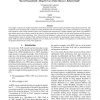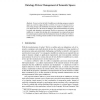ACL
2003
14 years 8 months ago
2003
Traditional vector-based models use word co-occurrence counts from large corpora to represent lexical meaning. In this paper we present a novel approach for constructing semantic ...
LREC
2008
14 years 8 months ago
2008
In this paper, we present an original framework to model frame semantic resources (namely, FrameNet) using minimal supervision. This framework can be leveraged both to expand an e...
LREC
2010
14 years 8 months ago
2010
This study examines the relationship between two kinds of semantic spaces -- i.e., spaces based on term frequency (tf) and word cooccurrence frequency (co) -- and four semantic re...
ICAIL
2007
ACM
14 years 8 months ago
2007
ACM
It is the concern of the author to arrange cogitations and experiences she gained by collaborating in relevant international project works, by conducting scientific studies regard...
SEMWEB
2007
Springer
15 years 24 days ago
2007
Springer
Recent work in the field of middleware technology proposes semantic spaces as a tool for coping with the scalability, heterogeneity and dynamism issues arising in large scale dist...


